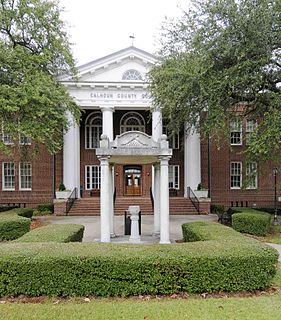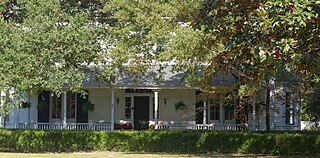
Darlington is a city located in Darlington County, South Carolina, United States. In 2010, its population was 6,289. It is the county seat of Darlington County. It is part of the Florence, South Carolina Metropolitan Statistical Area.

The Sumter County Courthouse, built in 1907, is an historic courthouse located at 141 North Main Street in the city of Sumter in Sumter County, South Carolina. It was designed in the Beaux Arts style by Darlington native William Augustus Edwards who designed eight other South Carolina courthouses as well as academic buildings at 12 institutions in Florida, Georgia and South Carolina. It was built in an I-shape. In the early 1960s it was enlarged and remodeled. On June 16, 2004, it was added to the National Register of Historic Places. It is located in the Sumter Historic District.

The Abbeville County Courthouse, built in 1908, is an historic courthouse located in the east corner of Court Square, in the city of Abbeville in Abbeville County, South Carolina. It was designed in the Beaux Arts style by Darlington native William Augustus Edwards who designed several other South Carolina courthouses as well as academic buildings at 12 institutions in Florida, Georgia and South Carolina. An arcade connects it to the adjoining Abbeville Opera House and Municipal Center, which Edwards also designed. In 1964, the courthouse was renovated by Lyles, Bissett, Carlisle, and Wolff of Columbia. On October 30, 1981, it was added to the National Register of Historic Places. It is included in the Abbeville Historic District.

The Lee County Courthouse, built in 1908, is a historic courthouse located at 123 S. Main Street in the city of Bishopville in Lee County, South Carolina. It was designed in the Classical Revival style by Darlington native William Augustus Edwards who designed eight other South Carolina courthouses as well as academic buildings at 12 institutions in Florida, Georgia and South Carolina. Lee County was created in 1902 and this is the only courthouse it has ever had.

The Dillon County Courthouse, built in 1911, is a historic courthouse located at 301 West Main Street in the city of Dillon in Dillon County, South Carolina. It was designed in the Classical Revival style by Darlington native William Augustus Edwards who designed eight other South Carolina courthouses as well as academic buildings at 12 institutions in Florida, Georgia and South Carolina. Dillon County was created in 1910 and this is the only courthouse it has ever had. On October 30, 1981, it was added to the National Register of Historic Places. It is located in the Dillon Downtown Historic District.

The Calhoun County Courthouse, built in 1913, is a historic courthouse located in the city of St. Matthews in Calhoun County, South Carolina. It was designed in the Colonial Revival style by Darlington native William Augustus Edwards who designed eight other South Carolina courthouses as well as academic buildings at 12 institutions in Florida, Georgia and South Carolina. Calhoun County was created in 1908 and this is its first and only courthouse. It was listed on the National Register of Historic Places in 1981.

The York County Courthouse, built in 1914, is an historic courthouse located at West Liberty and South Congress streets in the city of York in York County, South Carolina. It was designed in the Classical Revival style by Darlington native William Augustus Edwards who designed eight other South Carolina courthouses as well as academic buildings at 12 institutions in Florida, Georgia and South Carolina. On October 30, 1981, it was added to the National Register of Historic Places.

The Jasper County Courthouse, built in 1915, is an historic courthouse located in the city of Ridgeland in Jasper County, South Carolina. It was designed in the Colonial Revival style by Darlington native William Augustus Edwards who designed eight other South Carolina courthouses as well as academic buildings at 12 institutions in Florida, Georgia and South Carolina. Jasper County was created in 1912 and this is the only courthouse it has ever had, On October 30, 1981, it was added to the National Register of Historic Places.
William Augustus Edwards, also known as William A. Edwards was an Atlanta-based American architect renowned for the educational buildings, courthouses and other public and private buildings that he designed in Florida, Georgia and his native South Carolina. More than 25 of his works have been listed on the National Register of Historic Places.

Winnie Davis Hall, built in 1904, is an historic redbrick college building on the campus of Limestone College in Gaffney, South Carolina. It was designed by Darlington native William Augustus Edwards, who designed academic buildings at 12 institutions of higher learning as well as 13 courthouses and numerous other buildings in Florida, Georgia and South Carolina. It was named for Varina "Winnie" Anne Davis, the daughter of Jefferson Davis and was built to serve as a repository for American Civil War papers as a center for the study of Southern history. On April 29, 1977, it was added to the National Register of Historic Places. It is part of the Limestone Springs Historic District and is also known as the Winnie Davis Hall of History.
Currell College, completed in 1919, is an historic two-story redbrick university building on the campus of the University of South Carolina (USC) in Columbia, South Carolina in the United States. It was designed by Darlington native William Augustus Edwards who designed academic buildings at 12 institutions of higher learning as well as 13 courthouses and numerous other buildings in Florida, Georgia and South Carolina. Currell, which is pronounced as if it were spelled Curl, is the only building that Edwards built for USC. The Cain House at 1619 Pendleton Street which he designed in 1912 for a private owner, though, is now part of the expanded USC campus and is used as The Inn at USC.

This is a list of items on the National Register of Historic Places listings in Darlington County, South Carolina.
Edwards House or Edwards Farm or The Edwards House may refer to:
Springville is a ghost town in Darlington County, South Carolina, United States. There was a post office in operation from 1826 until 1832.
West Broad Street Historic District is a national historic district located at Darlington, Darlington County, South Carolina. The district encompasses 36 contributing buildings in a primarily residential section of Darlington. They were constructed between about 1890 and 1928. Most of the residences are grand in scale and reflect the prosperity of the individuals who built them. Several of the houses were owned by some of Darlington's most prominent citizens. Most of the residences are large, two-story frame Victorian or Queen Anne structures with decorative woodwork. The dwellings are set on deep lots that are planted with large trees and shrubs. A number of these large residences are similar in appearance and were built by master carpenter Lawrence Reese. Also included in the district are 13 modest, one-story frame houses with a few decorative features, as well as two imposing brick bungalows.

Charles S. McCullough House, also known as the Memorial Center, is a historic home located at Darlington, Darlington County, South Carolina. It was built in 1889, and is a 1+1⁄2-story, brick Second Empire style residence. It has a projecting one-story ell and a porch on three sides. The front porch has elaborate sawn brackets on paired turned posts and an ornamental balustrade. The front elevation features a steeply pitched gable, which rises above the top of the mansard roof.

Mrs. B. F. Williamson House, also known as the Williamson-Wilson House, is a historic home located at Darlington, Darlington County, South Carolina. It was built about 1898, and is a two-story, frame Queen Anne style dwelling. It has shiplap siding, a high complex roof, and tall interior chimneys. It features a wraparound porch with hip roof and turned posts. Also on the property is an original servant's cottage.
Wilds Hall, also known as the Peter A. Wilds House and Wilson House, is a historic home located at Springville, Darlington County, South Carolina. It was built about 1839, and enlarged to its present size about 1850. It is a 2+1⁄2-story, rectangular, weatherboard clad, frame residence with gabled roof. It sits on a low stuccoed brick pier foundation. Also on the property are four associated outbuildings. Peter Wilds was a wealthy planter owning 111 slaves in 1860. This house was lived in by four generations of the Wilds family over a 130-year period.

South Carolina Western Railway Station, also known as the Seaboard Airline Railway Station, is a historic train station located at Darlington, Darlington County, South Carolina. It was built in 1911 by the South Carolina Western Railway and is a rectangular brick building with projecting rectangular bays at the center of two sides. The hipped roof features a bell-cast profile, red clay tile, wide bracketed eaves, and intersecting gables. Each gable contains a Palladian window. Lawrence Reese, an African-American master carpenter who had constructed many houses in Darlington, built the station.

E. W. Cannon House and Store is a historic home and general store located at Hartsville, Darlington County, South Carolina. The main house was built about 1880 and incorporates a small one-story residence built about 1840 that now serves as a rear wing. It is a two-story, rectangular, frame residence with weatherboard siding. It features a one-story hip roof porch that extends across the full façade. The store was built about 1870 and is located to the rear of the house. It is a 1+1⁄2-story, rectangular, hand-hewn heavy timber-frame building that served as a post office from 1873 to 1878. Also on the property are a contributing frame garage and a frame smokehouse. The house and store were built by Elihu W. Cannon (1841-1911), prominent Hartsville farmer, postmaster, and Darlington County politician.















